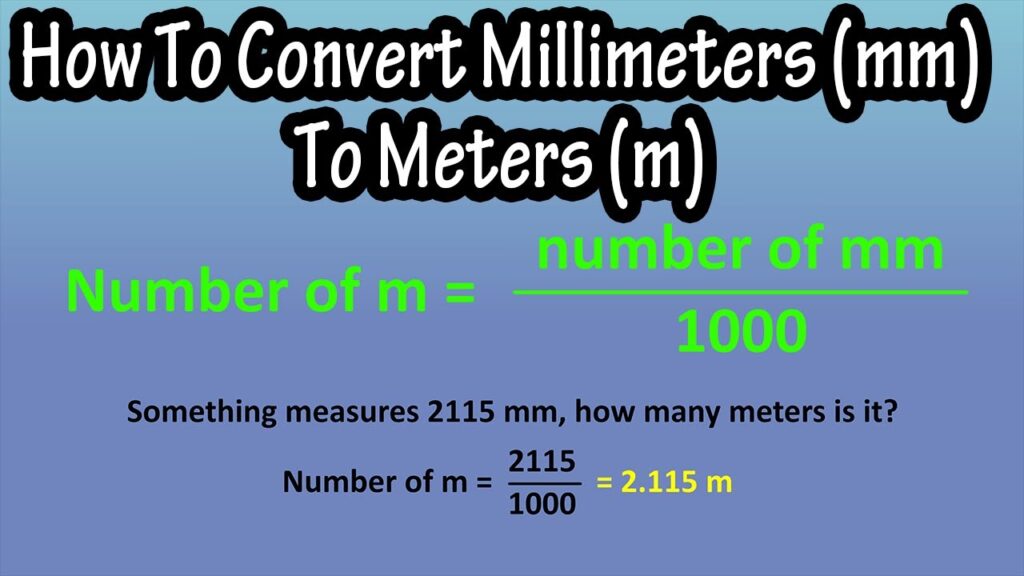Millimeters to Meters Converter (mm to m): Instant Formula, Chart, and Examples
Looking for a fast, precise mm to m converter? You’re in the right place. This guide explains the millimeters to meters relationship, gives you the mm → m formula, worked examples, a handy chart, spreadsheet recipes (Excel/Google Sheets), and practical tips for rounding and mixed units. Use it as a reference and bookmark it for later.
Quick answer: 1 millimeter (mm) = 0.001 meter (m)
Formula:m = mm ÷ 1000

Why convert mm to m?
Engineering drawings, interiors, CNC/3D printing, and site plans often move between millimeters (fine detail) and meters (bigger picture). Converting from mm to m improves readability for larger scales, reduces decimal noise, and keeps teams aligned—especially when hand-offs move from design to execution.
Good to know: This conversion is exact because both mm and m are SI units. A millimeter is one-thousandth of a meter, so there’s no approximation in the math—only in any rounding you choose afterward.
How to convert millimeters to meters (the easy way)
- Take your value in mm
- Divide by 1000 (
m = mm ÷ 1000) - Add the unit (m) and round only if needed
Example: 250 mm → 250 ÷ 1000 = 0.25 m
Mental trick: Move the decimal three places left to go from mm to m.
Worked examples (mm → m)
- 1 mm →
0.001 m - 10 mm →
0.01 m - 75 mm →
0.075 m - 120 mm →
0.12 m - 250 mm →
0.25 m - 500 mm →
0.5 m - 1000 mm →
1 m - 1700 mm →
1.7 m - 3000 mm →
3 m - 0.5 mm →
0.0005 m
Conversion chart (common mm → m values)
| mm | m | mm | m | |
|---|---|---|---|---|
| 1 | 0.001 | 250 | 0.25 | |
| 5 | 0.005 | 500 | 0.5 | |
| 10 | 0.01 | 1000 | 1 | |
| 50 | 0.05 | 3000 | 3 | |
| 75 | 0.075 |
Need a full table (0–3000 mm) as PDF/CSV? Make one in seconds or grab our printable: Length Converters.
Rounding and precision (engineering-friendly tips)
The mm → m conversion is exact; rounding is your choice and should match project tolerances:
- Estimates / sketches: 1–2 decimals (e.g., 1.7 m)
- General construction: often 2–3 decimals
- Tight tolerances / fabrication: keep more decimals or stick to mm to avoid premature rounding
Rule of thumb: Convert first, then round. If the source is 237.0 mm (4 significant figures), the unrounded result is 0.2370 m. Rounding the mm value before converting can create avoidable error downstream.
Mixed inputs: cm + mm to m (step-by-step)
- Convert everything to mm
cm → mmby multiplying × 10
- Add the parts in mm
- Convert to meters by ÷ 1000
Example: 23 cm 7 mm
23 cm = 230 mm230 + 7 = 237 mm237 ÷ 1000 = 0.237 m
FAQs: millimeters to meters (mm → m)
What’s the mm to m formula?m = mm ÷ 1000. It’s exact by SI definition.
How many meters in 1 mm?
0.001 m.
How do I convert 1700 mm to m?1700 ÷ 1000 = 1.7 m.
What precision should I use?
Match your tolerance: general work uses 2–3 decimals; tight fits keep more precision or stay in mm.
How do I convert back from meters to millimeters?
Use the reverse: mm = m × 1000.
